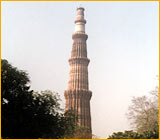 Qutub
Minar
Qutub
Minar
The origins of Qutab Minar are shrouded in controversy. Some believe it was
erected as a tower of victory to signify the beginning of the Muslim rule in
India. Others say it served as a minaret to the muezzins to call the faithful
to prayer. No one can, however, dispute that the tower is not only one of the
finest monuments in India, but also in the world.
Qutab-ud-din Aibak, the first Muslim ruler of Delhi, commenced the construction
of the Qutab Minar in 1200 AD, but could only finish the basement. His successor,
Iltutmush, added three more storeys, and in 1368, Firoz Shah Tughlak constructed
the fifth and the last storey. The development of architectural styles from
Aibak to Tughlak are quite evident in the minar. The relief work and even the
materials used for construction differ.
Some believe it was erected as a tower of victory to signify the beginning of
the Muslim rule in India. Others say it served as a minaret to the muezzins
to call the faithful to prayer. No one can, however, dispute that the tower
is not only one of the finest monuments in India, but also in the world.
Even in ruin, the Quwwat Ui Islam (Light of Islam) Mosque in the Qutab complex
is one of the most magnificent in the world. Its construction was started by
Qutab-ud-din Aibak in 1193 and the mosque was completed in 1197. additions were
made to the building by Iltutmush in 1230 and Alla-ud-din Khilji in 1315.
The main mosque comprises of an inner and outer courtyard, of which the inner
is surrouded by an exquisite collonade, the pillars of which are made of richly
decorated shafts. Most of these shafts are from the 27 Hindu temples which were
plundered to construct the mosque. It is, therefore, not surprising that the
Muslim mosque has typical Hindu ornamentation.
Close to the mosque is one of Delhi's most curious antiques, the Iron Pillar.
Dating back to the 4th century AD, the pillar bears an inscription which stated
that it was erected as a flagstaff in honour of the Hindu god, Vishnu, and in
the memory of the Gupta king Chandragupta II (375-413). How the pillar moved
to its present location remains a mystery.
Select a holiday
with us
 Qutub
Minar
Qutub
Minar